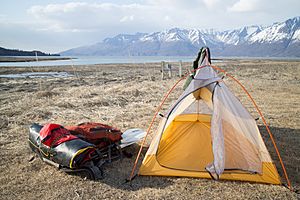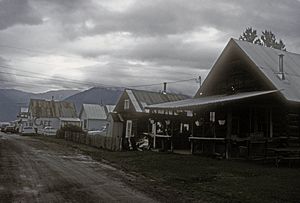Resurrection Creek facts for kids
Resurrection Creek is a stream located in the Kenai Peninsula in Alaska, USA. It flows into Turnagain Arm, a part of the ocean. Other streams like Bear Creek, Sixmile Creek, and Glacier Creek also join Turnagain Arm.
The area of land that drains water into Resurrection Creek is about 161 square miles (417 square kilometers) on the northern side of the Kenai Peninsula. The small town of Hope, Alaska is found right where the creek meets Turnagain Arm. The Hope Highway runs next to Resurrection Creek, making it easy to visit.
Contents
Exploring Resurrection Creek's Geography
Resurrection Creek was the first place in this region where gold was found! The creek flows through a wide valley filled with a lot of gravel. Over time, the water has carved a deep, canyon-like path through these gravels.
The part of the creek where gold was discovered, between Sixmile Point and Hope, slopes down about 66 feet (20 meters) for every mile. The lower 20 miles (32 kilometers) of the creek drop even more, about 100 feet (30 meters) per mile. The gravels in the valley are layered and have been found to be at least 50 feet (15 meters) deep below the stream. These gravels are mostly made of rocks from the nearby hills, but some are also from other areas.
Streams That Feed Resurrection Creek
Several smaller streams flow into Resurrection Creek, bringing more water and sometimes more interesting things!
Palmer Creek
Palmer Creek is the biggest stream that flows into Resurrection Creek. It's an important part of the creek's water system.
Bear Creek
Bear Creek is a well-known stream in this area. It's about 5 miles (8 kilometers) long and drops almost 500 feet (152 meters) per mile, making it quite steep! Bear Creek valley is narrower than Palmer Creek valley.
The rocks around Bear Creek are mostly layered arkoses (a type of sandstone) and bluish-black slates. The gravels in Bear Creek are mostly made of these local rocks. Sometimes, large boulders, 3 to 4 feet (0.9 to 1.2 meters) wide, are found here.
Bear Creek gold is a bit different from other gold in the Resurrection area. It's usually bright yellow, but can sometimes look whitish. Miners have also found some silver and even a small amount of copper here. One very large gold nugget, worth about $250 at the time, was discovered!
The first mining claim on Bear Creek brought in over $2,000 in its first year. Another claim was worked steadily for many years, producing about $8 per day for each miner. Two special machines called "hydraulic plants" were also set up on Bear Creek to help with mining. These plants used strong jets of water to wash away gravel and find gold.
The Gold Rush History of Resurrection Creek
In the 1890s, Resurrection Creek became famous as the site of Alaska's very first gold rush! People rushed to the area hoping to find their fortune.
A man named Charles Miller was the first to claim land for mining on the creek. He then allowed other miners to work on his claim. By 1893, about a dozen miners were already busy working on claims along the creek. The next year, even more claims were started on Resurrection Creek as the gold rush grew.
During the gold rush of the 1880s and 1890s, Tyonek was a very important port city. However, after the city of Anchorage was established, Tyonek became less important.



